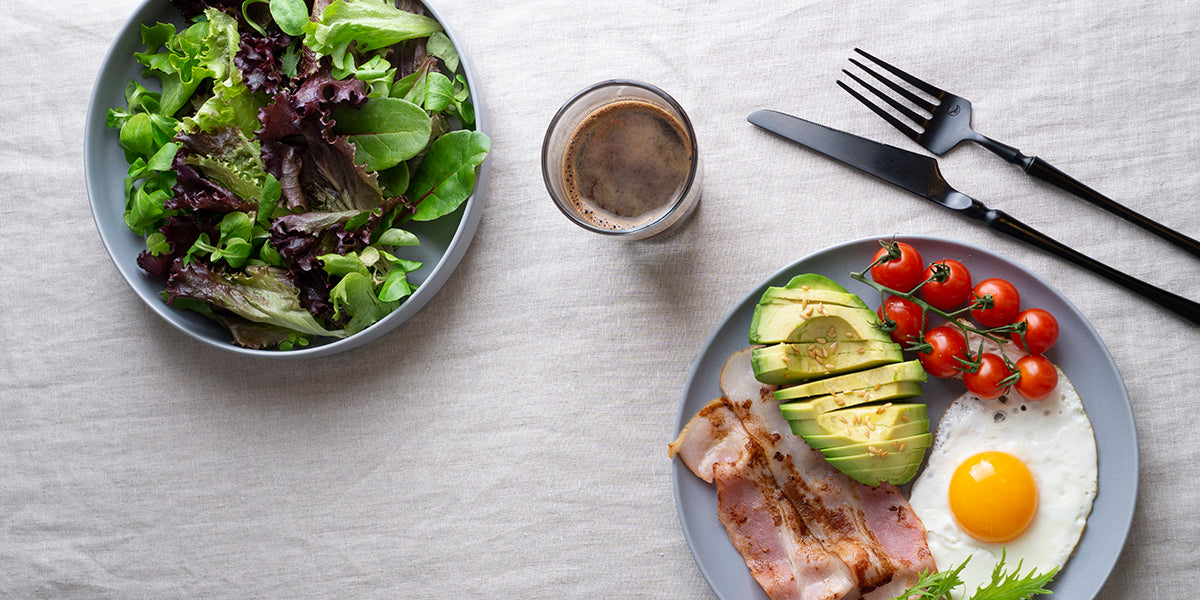
Basics of a low-carb diet
In recent years, the popularity of low-carb diets has exploded. People are looking into this lifestyle approach to achieve their wellness goals.
By now it is clear that cutting your sugar and refined carbs intake would improve your health but there is more you might want to know if you want to give this a try.
In this post we will explore the basics of a low-carb diet, its potential benefits, and the basic food items you should include in your next trip to the supermarket.
Understanding the (very) basics of a low-carb diet
A low-carb diet is characterized by a reduction in the intake of carbohydrates, one of the three macronutrients essential for our body. Carbohydrates are commonly found in grains, fruits, vegetables, legumes, and dairy products. By limiting the consumption of these foods, the body is encouraged to burn stored fat for energy, leading to potential weight loss and improved metabolic markers.
Is it a restrictive diet? Not really, Even higher carb foods like fruits, starchy vegetables, and whole grains can fit into some low carb diets in moderation.
There are several types of low carb diets, and they differ based on the amount of carbs permitted each day. A typical low carb diet usually contains less than 26% of total daily calories from carbs. For a reference, in a 2000 calorie diet, this equals fewer than 130 grams (g) of carbs per day.
Types of Low-Carb Diets
There are several approaches to a low carb diet which creates some confusion. Some of the most known are: keto, atkins, paleo or dukan.
There are different options, each of which varies based on how many carbs in a low-carb diet are included, plus the amounts of other nutrients in the diet, such as protein or fat.
Finding the best low-carb diet plan for weight loss or better health all comes down to deciding what works best for you.
High-Protein, Low-Carb Diet:
Opting for a low-carb, high-protein diet entails a dietary breakdown of approximately 30-35% protein, 20% or less carbohydrates, and roughly 45-50% fat (% of calories). To ensure balanced meals, consider incorporating one to two palm-sized portions of protein, such as fish or meat, with each serving.
When comparing high-fat and high-protein diets, the key distinction lies in the protein intake&mdashderived from sources like meat, fish, or eggs. While higher-fat diets like keto emphasize increased healthy fats through butter, oil, and fattier cuts of meat, higher-protein diets also include fats but in reduced quantities.
High-Fat, Low-Carb Diet:
This is a ketogenic diet, which eliminates almost all sources of glucose in order to put the body into ketosis or fat burning mode.
When adhering to a conventional ketogenic diet, your daily calorie intake comprises roughly 75 percent from healthy fats, 5 percent from carbohydrates, and approximately 20 percent from protein. Generally, ketogenic diets set a daily limit for net carb intake, usually ranging between 20 to 30 grams. This calculation involves subtracting the grams of fiber from the total carb count.
Low-Fat, Low-Carb Diet:
Fat has been demonized for so many years that many people think that you need to follow a low-carb, low-fat diet to lose weight and improve your health. This propaganda about fat leads people to identify dietary fat with body fat, thus, if you eat less fat you will be less fat.
However, this couldn’t be further from the truth, filling up on healthy fats can actually be incredibly beneficial for overall health.
Ideally, you should get a good amount of healthy fats in your diet from foods like fatty fish, organic meat, olive oil, avocados, nuts and seeds.
(Main) Benefits of a Low-Carb Diet
- Weight Loss: One of the primary reasons individuals adopt a low-carb diet is for weight management. The reduction in carbohydrates can lead to decreased insulin levels, promoting fat breakdown and weight loss.
- Blood Sugar Control: Low-carb diets have shown effectiveness in managing blood sugar levels, making them a valuable tool for individuals with type 2 diabetes or those at risk of developing the condition.
- Improved Cardiovascular Health: Some studies suggest that low-carb diets can positively impact cardiovascular health by reducing risk factors such as triglycerides, blood pressure, and increasing levels of HDL (good) cholesterol.
- Increased Satiety: High-fat and protein-rich foods common in low-carb diets can enhance feelings of fullness, reducing overall calorie intake and aiding in weight management.
Foods to eat:
We know that starting new habits can be a bit overwhelming, so below you can find a very simple list of foods you can include in your next grocery list.
The good part of following a low carb diet is that it includes lots of tasty foods that you will enjoy very much
Vegetables:
- Leafy Greens: Spinach, kale, Swiss chard, and arugula.
- Cruciferous Vegetables: Broccoli, cauliflower, Brussels sprouts, and cabbage.
- Low-Carb Veggies: Zucchini, asparagus, bell peppers, and mushrooms.
Proteins*:
- Quality Meats: Chicken, turkey, beef, and pork.
- Fatty Fish: Salmon, trout, tuna, and mackerel.
- Eggs
- Tofu and Tempeh: if you are vegan or vegetarian.
*When choosing an animal protein source we recommend choosing organic, wild caught, grass fed or cage free stuff if possible. Some kind of assurance that the animals have been feed and raised in the proper way.
Fats:
- Extra Virgin Olive Oil: A heart-healthy source of monounsaturated fats.
- Nuts and Seeds: Almonds, walnuts, chia seeds, and flaxseeds.
- Coconut Oil: A source of medium-chain triglycerides (MCTs).
Dairy*:
- Cheese: Cheddar, mozzarella, feta, and cream cheese.
- Greek Yogurt: Opt for the plain, unsweetened variety.
- Heavy Cream: Used in moderation for cooking and coffee.
*Same as your protein sources, choose organic or grass fed when possible
Fruits:
- Berries: Strawberries, blueberries, and raspberries.
- Avocado: While technically a fruit, it's low in carbs and high in healthy fats.
Grains and Alternatives:
- Cauliflower Rice: A low-carb substitute for traditional rice.
- Almond Flour: Used in baking as a low-carb alternative to wheat flour.
- Chia Seeds: High in fiber and versatile for puddings and smoothies.
Snacks:
- Olives: Source of monounsaturated fats and vitamin E.
- Jerky: High-protein, low-carb option, we make the best and cleanest
- Vegetable Sticks with Dip: Celery, cucumber, or bell pepper with guacamole or hummus.
Sweeteners (in moderation):
- Stevia: A natural sweetener with zero calories
- Erythritol: The most natural sugar alcohol with minimal impact on blood sugar.
Remember to focus on whole, minimally processed foods to ensure a well-rounded and nutrient-dense low-carb diet. It's always advisable to customize your food choices based on personal preferences, dietary restrictions, and health goals. Additionally, consulting with a healthcare professional or a registered dietitian can provide personalized guidance tailored to your individual needs.
We hope this brief guide will help you to start implementing more clean and healthy foods habits. We will be more than happy to receive your feedback or ideas for next blog posts.
References:
- Westman, E. C., et al. (2008). The effect of a low-carbohydrate, ketogenic diet versus a low-glycemic index diet on glycemic control in type 2 diabetes mellitus. Nutrition & Metabolism, 5(1), 36.
- Shai, I., et al. (2008). Weight loss with a low-carbohydrate, Mediterranean, or low-fat diet. New England Journal of Medicine, 359(3), 229-241.
- Bazzano, L. A., et al. (2014). Effects of low-carbohydrate and low-fat diets: a randomized trial. Annals of Internal Medicine, 161(5), 309-318.
- Landry MJ, Crimarco A, Gardner CD. Benefits of Low Carbohydrate Diets: a Settled Question or Still Controversial? Curr Obes Rep. 2021 Sep;10(3):409-422. doi: 10.1007/s13679-021-00451-z. Epub 2021 Jul 23. PMID: 34297345; PMCID: PMC9621749.
- Oh R, Gilani B, Uppaluri KR. Low-Carbohydrate Diet. 2023 Aug 17. In: StatPearls [Internet]. Treasure Island (FL): StatPearls Publishing; 2023 Jan–. PMID: 30725769.





